Journal of
Asian Martial Arts
 |
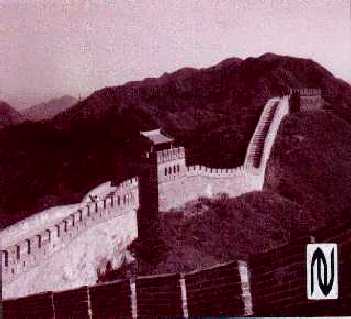 |
| Volume 2 - Number 2 -
1993 |
INCREASED LUNG CAPACITY THROUGH
QIGONG BREATHING
TECHNIQUES OF CHUNG MOO DOE
BY PATRICK B. MASSEY, M.D., Ph.D., EUGENE THORNER, M.D. WILLIAM L. PRESTON, M.D.
& JOHN S. LEE, M.D.
Introduction
There are many reports of the healthful benefits of martial art training
(Zhao, 1984; Maliszewski 1992). Usually these reports consist of martial art
experts, as well as students, attesting to the value of their training programs.
These benefits can include improved physical fitness, resolution of specific
body problems and a subjective feeling of mental improvement. However, objective
evidence on the effectiveness of martial art training for improving the health
of the average student is lacking.
Martial art training involves the performance of specific movements over a
period of time until a certain proficiency is achieved. One important aspect of
many advanced martial art training programs involves the development of some
form of breathing control. Specific breathing forms (qigong) have been
alleged to improve the circulation and strengthen both the immune system and the
internal organs. Other qigong breathing forms stretch the muscles, clear
the mind and reduce stress (Eisenberg, 1985; Wilhelm, 1985). Qigong means
the practice of developing qi. Qi has been described as the energy
of the body. It is associated with breathing as well as muscle and mental
activity. It is more of a life energy than a measurable substance (Ming-Dao,
1990). Qigong breathing techniques are taught in the Chung Moo style of
martial art. Chung (mind) Moo (body) martial art (also known as Um Yang martial
arts) has its foundation in Chinese martial arts. It was first introduced into
the United States twenty years ago.
Our own positive experiences practicing qigong breathing (a cumulative
experience of twenty- nine years in the Chung Moo style of martial art) led us
to interview many other students who also practice qigong breathing
forms. They stated that they felt "energized" after practicing qigong
breathing and they were able to complete daily activities more easily. Many
stated that they had fewer colds, more energy and greater endurance. Some of
these students originally had been severe, activity-restricted asthmatics. After
practicing qigong breathing, they became very active and also noticed a
marked decrease in the use of their asthma medications (Massey and Thorner,
1992). We wanted to determine if there was a measurable, physiologic parameter
that could justify the apparent feeling of improved health in those practicing
qigong breathing. Since the students were practicing a specific breathing
form, the most obvious parameter to measure was the amount of air each student
could exhale with a single breath. We postulated that, through qigong
breathing techniques, there may be a significant increase in the lung capacity.
We compared the functional lung capacity in those students who practiced
qigong breathing with the lung capacities of an age- and height-matched
control population (national average). Our data confirmed that students who
practiced qigong breathing had a marked increase in their lung capacity.
METHODS
One hundred students training in the Chung Moo style of martial art
volunteered to participate in this study. Students were randomly selected and
represent an age span of between twenty and seventy-one years of age. All had
been practicing qigong breathing forms for at least four months.
The lung capacity of each student was measured using an Assess Peak Flow
Spirometer. Students, after taking a deep breath, would expel as much air as
possible, as fast as possible into the spirometer. The flow of air (liter/min.)
was measured by the spirometer. Spirometry was performed four consecutive times
per student. All students were evaluated before practicing qigong
breathing forms. The numeric value for each student was determined as the
average of the four attempts. The numeric value of each age group was an average
of all of the students in that age group.
The numeric value of lung capacity was calculated by using the national
standards for lung capacity and peak air flow volumes. Since lung capacity is
directly related to both age and height, student’s lung capacities were compared
with national averages for both their age and height (Leiner et al., 1963).
RESULTS
| A Sample Qigong Breathing
Technique |
| Photos courtesy of E. Thorner |
Figure I-1
Air is drawn into the lungs through the
nose as the arms and leg move to one side in unison. |
 |
Figure I-2
Intake of air is completed as the arms
reach the level of the shoulders. The air is then pushed into the abdomen,
ready for expulsion. |
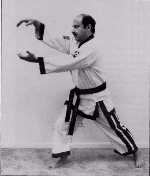 |
Figure I-3
Air is released in a controlled manner
as the arms move downward. |
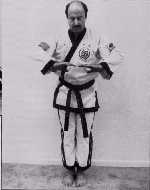 |
Figure I-4
The movement is completed with total
release of the air, an extension of the arms toward the toes and a pulling
in of the stomach. *The entire sequence can then be
repeated. |
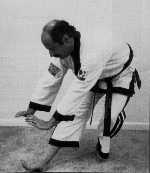 |
Figure I: Qigong breathing practiced by students in the Chung Moo
style of martial art. One of many different qigong breathing forms is
demonstrated. Air is taken in through the nose (Figs. I-1 and 2), forced down
into the abdominal area (Figs. I-3) and finally expelled through the mouth while
contracting the abdomen (Figs. I-3 and 4). These and other similar breathing
movements are practiced for twenty minutes per day, three to four times a week.
Movements are done in a relaxed manner and are continuous. Qigong
breathing movements are done an equal number of times on the right and left
side.
INCREASED PEAK FLOW RATE
IN STUDENTS PRACTICING QIGONG
BREATHING
IN THE CHUNG MOO-STYLE OF MARTIAL ART |
 |
(a) Liters of air per minute
[] Number of students per
group |
Figure II: Increased peak flow rate in students practicing qigong
breathing in the Chung Moo Style of martial art. The peak flow for each age
group represents the maximum speed at which air was expelled from the lungs
after a single deep breath. Each value is the average of four measurements for
each student in the specific age group. These values were compared to the
national average for each age group. The national average peak air flow declines
with increasing age. In comparison, there was no decline in the peak air flow
for those students between the ages of twenty and seventy-one who practiced
qigong breathing.
PERCENT INCREASE IN LUNG CAPACITY
OF STUDENTS
PRACTICING QIGONG BREATHING
IN THE CHUNG MOO-STYLE OF MARTIAL ART |
 |
Figure III: Percent increase in the lung capacity of students practicing
qigong breathing in the Chung Moo martial art style. These data show that
the greatest percent increase in lung capacity is in the older students (between
thirty-six and seventy-one years of age) who practiced qigong breathing.
For comparison purposes, the national average lung capacity for each age group
was set at 100%. As a result, in the older students, the lung capacities were
30-45% greater than age- and height-matched controls (national average). A
smaller but significant increase over the national average (20-25%) was seen in
the younger students.
DISCUSSION
As the human body ages, certain functions diminish. There is a decrease in
hearing, eyesight, muscle mass, bone density, memory and learning. Reaction time
dramatically increases. There is also a decrease in lung capacity that is
believed to be irreversible (Poppy, 1992). This loss of lung capacity may
reflect structural chances of the chest shape resulting from increased curvature
of the spine and a loss of postural height ( most commonly the result of
osteoporosis). There are also changes in the lung tissue itself. The lung tissue
loses some of its elasticity. This is the result of years of scarring by
multiple insults to the lung tissue, e.g., exposure to toxins in our
environment: pollution and tobacco smoke. Scarring will also occur as the result
of the immune response to infections (pneumonia) and allergens (asthma). As the
amount of scarring increases, the lung tissue becomes less flexible (like a dry
balloon). The measurable result of a stiff lung is a decreased lung volume.
Although antioxidants and specific aerosolized enzymes do hold promise in some
specific lung diseases, this is not applicable to the general population; there
are no drugs that can stay the ravages of time (Hubbard et al. 1989). In other
words, the loss of lung function is not believed to be reversible to any great
degree. It is simply an unfortunate result of the inevitable aging process.
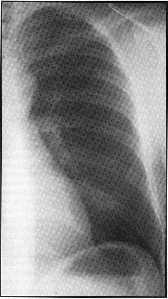 |
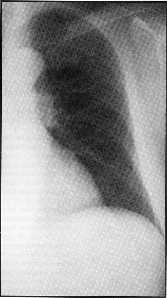 |
| A thirty year old male. |
A seventy-six year old male. |
X-Rays comparing the left lung
of a
young adult male with that of an elderly male.
The reduction of
lung capacity
is largely due to the effects of ageing.
However, this
common tendency for the
lungs to progressively decrease in
function
can be beneficially impeded by regular
practice of qigong
breathing exercises. |
The practice of martial arts emphasizes that loss of function may not be
permanent and that through the proper training, the aging process can be slowed.
There are many examples of older martial art students who can perform physical
tasks as well as someone many years younger (Ming-Dao, 1990 and Maliszewski,
1992). We documented that the practice of qigong breathing techniques
made many students subjectively more energetic, increased their stamina. However
we were interested in objectively documenting if this feeling of increased
stamina was related to any physical changes in the students. The most obvious
place to start was to measure lung capacity.
Qigong may have been originally introduced into Chinese martial arts
by various Daoist groups. These breathing techniques were greatly enriched in
the Tan Dynasty by the incorporation of breathing forms traditionally introduced
to the Chinese by the Indian Buddhist monk Bohidharma. Eventually, qigong
movements found their way into many Chinese martial art forms (Ming-Dao, 1990).
Qigong incorporates many different positions and movements and is most
often associated with promotion of health through the development of internal
strength (Chang, 1978). These breathing techniques are so intertwined with
Chinese martial arts that now it is almost impossible to practice advanced
martial art forms without being introduced to some form of qigong
breathing.
We wanted to evaluate the effects of qigong breathing on the lung
capacity. We needed a large group of participants who were all practicing the
same set of breathing movements. In this way the individual results from each
age group could be combined. We chose to evaluate students practicing the Chung
Moo style of martial art. The Chung Moo style has deep roots in Chinese martial
arts and specific qigong breathing forms are part of the training
program. Chung means a "balanced mind" and Moo means a "strong body." Chung Moo,
a name used generally throughout Asia, can also represent the aspects of Yin and
Yang (Chinese) or Um Yang (Korean), signifying a balance between the mind and
the body.
Practice of the qigong breathing movements involves a controlled
intake of a large volume of air into the lungs. The air is then pushed into the
abdominal area and then is followed by a controlled expelling of the air (Fig.
I). Our data confirmed the hypothesis that there was a measurable improvement in
lung capacity related to the subjective feeling of improved stamina in those
students practicing qigong breathing techniques. The older students
apparently realized the greatest benefit. Their resultant lung capacities were
much greater than their age- and height-matched controls (Fig. III). This may
reflect that an older student initially has a smaller lung capacity than a
younger student. Between the age of twenty and seventy-one, in the general
population, there is a loss of at least 30-35% of the lung capacity, the
equivalent of having one-third of the total lung mass surgically removed (West,
1977). However, this "lost" capacity is apparently not lost forever. After they
practiced qigong breathing techniques, the lung capacity of the older and
younger students were not statistically different (Fig. II). Interestingly, even
the younger students demonstrated a significant increase in lung capacity. This
indicates that there is considerable room for improvement even in the younger
student.
Unlike a machine, in the human body, specific organs, joints and tissues
become more efficient, more flexible or more supple with increased use (in the
right manner). Qigong breathing promotes a remarkable increase in the
lung capacity. Whether the increase in lung capacity reflects an increase in the
chest wall size or an increase in flexibility of the lung tissue itself can not
be determined from this study. One intriguing possibility is that qigong
breathing may train the student to tap into this large lung volume (West, 1977).
A whale, however, can exchange greater than 90% of its total lung volume.
Qigong breathing may train the student to tap into this large lung volume
reserve with every breath, to become more efficient in breathing. Again, this
study cannot answer this hypothesis.
As with all scientific studies, more questions are raised than answered.
Would breathing forms in other martial art styles compare favorably with those
taught in the Chung Moo style martial art? How fast do qigong breathing
techniques increase lung volume? Could qigong breathing movements reverse
the severe lung damage from emphysema and cystic fibrosis? How long do the
benefits last after stopping qigong breathing? What other organ systems
does qigong breathing affect? Preliminary blood pressure studies on
students practicing qigong breathing indicate that circulation is also
favorably influenced (data not published). It is clear that martial art training
and the study of medicine both seek answers to the same questions to understand
how the human body works. The combination of martial arts and medicine is
exciting in that new insights into how the human body works may be found.
REFERENCES
- Cheng, Stephen T. (1978). The book of internal exercises. San
Francisco:Strawberry Hill.
- China Sports Magazine. (1985). The wonders of qigong: A Chinese
exercise for fitness, health, and longevity. Los Angeles: Wayfarer.
- Eisenberg, David. (1985). Encounters with qi: Exploring Chinese
medicine. New York: Norton.
- Hubbard, R., McElvaney, N., Sellars, S., Healy, J., Czerski, D., Crystal,
R. (1989). Recombinant DNA- produced alpha 1-antitrypsin administered by
aerosol augments lower respiratory tract anti-neutrophil elastase defenses in
individuals with alpha 1-antitrypsin deficiency. Journal of Clinical
Investigation, 84, 1349-54.
- Leiner, G. C., Abramowitz, S., Small, M., Stenby, V.,Lewis, W. (1963).
Expiratory peak flow rate. Standard values for normal subjects. Use as a
clinical test of ventilary function. American Review of Respiratory
Diseases, 8, 644-48.
- Maliszewski, Michael. (1992). Medical, healing and spiritual components of
Asian martial arts. Journal of Asian Martial Arts, 1 (2), 25-56.
- Massey, Patrick and Thorner, Eugene. (1992). Personal testimonials
gathered from students practicing the Chung Mo style of martial art.
- Ming-Dao, Deng. (1990). Scholar warrior: An introduction to the Tao in
everyday life. San Francisco: Harper and Row.
- Poppy, John. (1992). How old are you really? Health, 6(7),
45-56.
- West, John B. (1977). monary pathophysiology: The essentials.
Baltimore: Williams and Wilkins.
- Zhao, Dahong. The Chinese exercise book: From ancient and modern
China-Exercises for well-being and the treatment of illness. Point
Roberts, Washington: Hatley and Marks.
|
